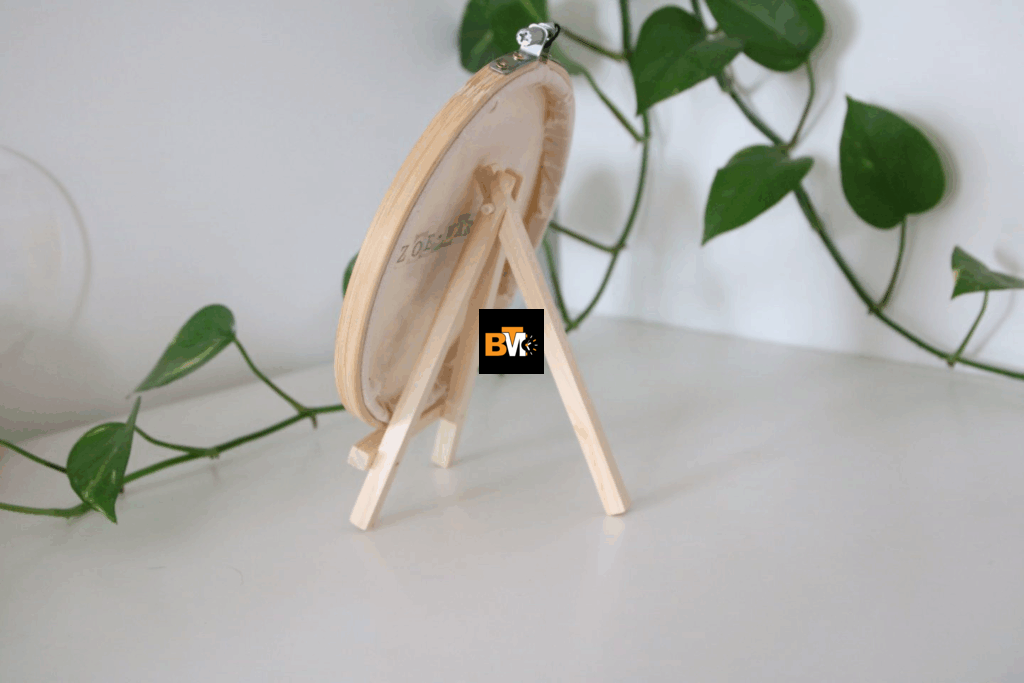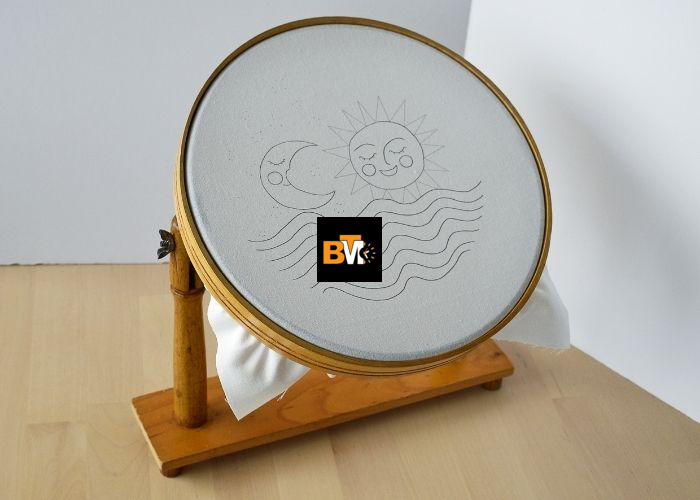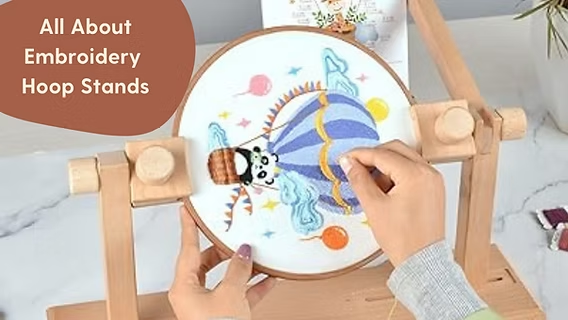If you’ve ever tried embroidery, you probably know how tricky it can be to hold your fabric still while stitching. That’s where a standing embroidery hoop comes in. It’s a special tool that holds your hoop up for you—no need to grip it with one hand while trying to sew with the other. Whether you’re a beginner or a pro, a standing embroidery hoop can make stitching easier, faster, and a whole lot more fun!
What Is a Standing Embroidery Hoop?
A standing embroidery hoop is a clever little tool that holds your embroidery hoop in place using a stand. The hoop is attached to an adjustable arm or clamp, which is connected to a base that either sits on the floor or a table. Some versions even come with rotating or tilting features so you can move your hoop into the perfect position for stitching.
Unlike regular hoops that you have to hold in one hand, a standing embroidery hoop frees up both hands. This is really helpful for people doing detailed or two-handed embroidery work like cross stitch, punch needle, or crewel. Because it’s hands-free, your stitches can become more precise, your posture improves, and you can even work longer without feeling tired.
These hoops come in different materials like wood, plastic, or metal. Most of the high-quality versions use bamboo embroidery hoop, beechwood hoop, or durable metal for the frame. Whether you’re working on a large embroidery project or just trying to finish a simple needlepoint pattern, a standing embroidery hoop can save you a lot of time and effort.
Why People Love Using It
People love using standing embroidery hoops for a lot of good reasons. First, they help reduce strain on your hands and arms. Holding a hoop for a long time can make your hand sore or even cause cramps. With a standing hoop, your hands stay free, so you’re more relaxed and can focus better on your stitching.
Another reason is posture. When you use a tabletop or floor-standing embroidery hoop, you don’t have to hunch over your work. You can sit straight and bring the hoop up to eye level. This makes a big difference if you’re working for a few hours at a time.
Also, standing hoops are great for doing two-handed embroidery, which means one hand goes above the fabric while the other stays below. This makes your work faster and helps your stitches stay neat and even. Some people also say that using a standing hoop helps them make fewer mistakes.
If you use counted cross stitch hoop or do embroidery on large fabric, the standing hoop can hold big or thick pieces of cloth without slipping. It gives you a steady, tight surface to work on. That’s why both hobbyists and professionals trust standing embroidery hoops for their crafting.
Where Can You Use a Standing Hoop?
One of the best things about standing embroidery hoops is that you can use them in many different places. Whether you’re relaxing at home, teaching others, or helping someone who needs extra support, these hoops are incredibly versatile.

Great for Home Use
At home, a standing embroidery hoop makes crafting much more comfortable. You can place it on a desk, dining table, or even sit with it on your lap if you have a smaller tabletop model. If you’re watching TV or listening to music, you don’t have to keep stopping to adjust your fabric. It stays secure, and you can focus on your fun project. People love using standing hoops during their free time, especially when making handmade gifts, home decor, or custom embroidery.
Good for Schools or Classes
Standing embroidery hoops are also popular in schools or community centers. When students are learning to stitch, it helps a lot if they don’t have to worry about holding the fabric. It gives them the freedom to focus on technique and design. For group classes, teachers often use embroidery floor stands or adjustable embroidery frames so each person has a stable surface to work on. This makes learning easier and more fun, especially for kids and beginners.
Handy for Older People
For older people or anyone with limited hand strength, these hoops can be a game changer. Arthritis, hand tremors, or weakness can make holding a hoop really hard. A standing hoop takes away that problem. Some versions even come with magnifiers for embroidery, which help people with low vision see their stitches more clearly. It’s a great way for seniors to keep enjoying a craft they love without strain or frustration.
Different Types of Standing Hoops
There are many types of standing embroidery hoops, and each one has its own special features. Some stand on the floor, while others are small enough to sit on a tabletop or your lap. Here are the main types you’ll see:
- Floor-standing embroidery hoops: These have a tall stand that rests on the ground and can be used while you sit on a chair or couch. They usually come with adjustable height and tilt.
- Tabletop standing hoops: These are smaller and lighter. You can place them on any flat surface like a desk or kitchen table. Perfect for small projects and easy storage.
- Lap embroidery hoops: These hoops come with a base that rests on your lap. They’re portable and great for traveling or working in bed.
- Rotating hoops: Some standing hoops can rotate 360 degrees. This means you can easily flip your fabric over without taking it out of the hoop. It’s a must-have feature for double-sided embroidery.
- Clamp-based hoops: These use a clamp to grip your regular hoop and attach it to a base. You can use your favorite hoop and turn it into a standing one.
No matter which kind you choose, make sure it suits the type of embroidery you like to do. From DIY embroidery frames to professional cross stitch stands, there’s a standing hoop for everyone.
How to Choose the Best One
Choosing the right standing embroidery hoop depends on what you need. Start by thinking about how and where you do most of your stitching. Do you sit at a table or on the couch? Do you work on small pieces or large fabric? Do you need something that’s easy to store?
Here are some key points to keep in mind:
- Adjustability: Choose a hoop that lets you change the height and angle. This helps with comfort and makes it easier to stitch for longer periods.
- Size of the hoop: Look for a hoop that fits the size of the fabric you usually use. A large hoop is great for bigger projects, while a smaller hoop works well for details.
- Material: Wooden hoops are classic and lightweight, while metal hoops are strong and long-lasting. Make sure the base is also sturdy so it doesn’t wobble.
- Portability: If you travel or move your work around, choose a lightweight or foldable version.
- Budget: You don’t need to spend a fortune to get a good hoop. There are many affordable standing hoops that work just as well as expensive ones.
Also look for extra features like quick-release knobs, rotating clamps, or dual hoop holders. These little details can make your stitching smoother and more enjoyable.
Standing Hoops vs. Regular Hoops
You might be wondering, “Do I really need a standing embroidery hoop, or is a regular hoop enough?” Let’s compare the two so you can decide which one fits your style better.

Which One is Easier to Use?
Regular hoops are simple and easy to carry around. They’re great for beginners who are just learning to stitch. But if you plan to do more detailed work, a standing hoop is easier in the long run. You don’t have to keep adjusting the fabric, and you can use both hands freely. This makes standing hoops a better choice for projects that take a lot of time or require careful stitching.
What About Price?
Standing hoops usually cost more than regular hoops because they have more parts and features. But think of it like an investment. If you’re going to spend a lot of time on embroidery, it makes sense to get tools that make the job easier and more comfortable. There are also many budget-friendly options available under $50, especially in brands like Morgan embroidery stand, Dritz floor stand, or Frank A. Edmunds stitch master.
Best Fabrics to Use in a Standing Hoop
Standing hoops can handle almost any kind of fabric. But they’re especially good for:
- Aida cloth
- Linen fabric
- Cotton canvas
- Muslin fabric
- Evenweave cloth
These fabrics stretch well and stay tight in the hoop. If you’re working with slippery or stretchy fabrics, look for hoops with extra grip or use fabric stabilizers to keep things neat.
Tips for Beginners Using a Standing Hoop
If you’re new to embroidery and just bought your first standing hoop, don’t worry! It’s easy to get started. First, make sure the hoop is tightened properly so your fabric doesn’t sag. Adjust the height and angle to match your sitting position. Try to keep your back straight and relax your arms. Use both hands to make even stitches, and take breaks often to rest your eyes and fingers.
Also, don’t be afraid to practice on scrap fabric before starting a big project. The more you use your hoop, the more natural it will feel. Keep your tools like scissors, thread, and needles nearby so you don’t have to stop and look for them.
The Bottom Line
A standing embroidery hoop is one of the best tools you can have if you enjoy embroidery. It holds your work steady, lets you use both hands, and helps you stay comfortable during long stitching sessions. Whether you’re making gifts, decorating clothes, or just passing the time with a relaxing hobby, a standing hoop can make everything easier.
From kids learning to stitch to seniors enjoying their favorite craft, these hoops are loved by all. There are many types to choose from, so take your time and find one that fits your needs. And remember, the right tools can turn a good hobby into a lifelong passion.







Leave a Reply